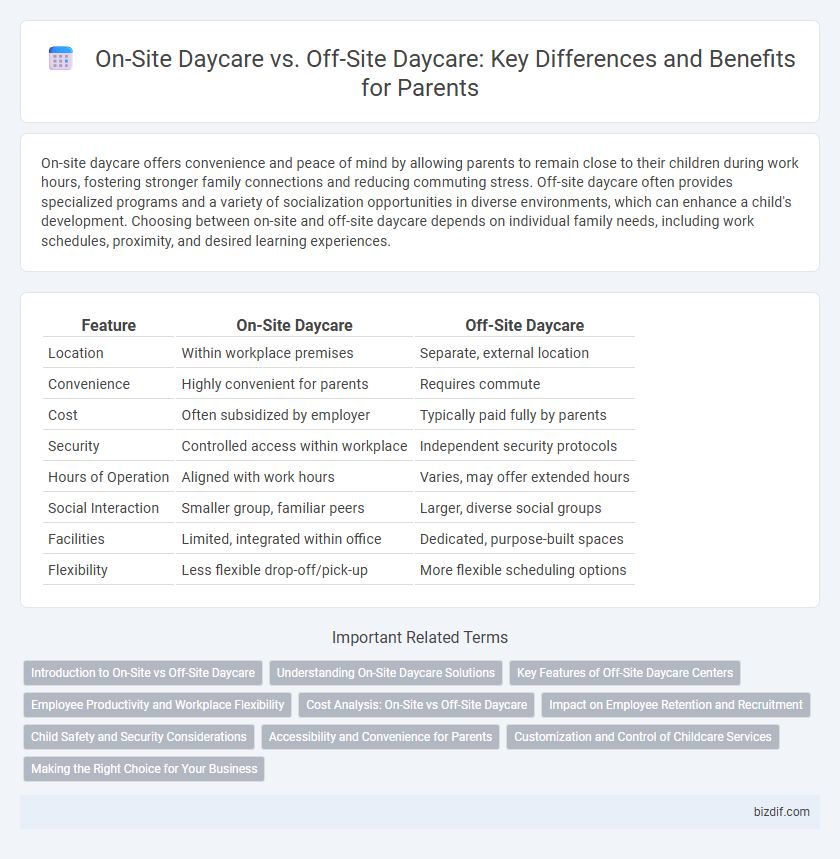On-site daycare offers convenience and peace of mind by allowing parents to remain close to their children during work hours, fostering stronger family connections and reducing commuting stress. Off-site daycare often provides specialized programs and a variety of socialization opportunities in diverse environments, which can enhance a child's development. Choosing between on-site and off-site daycare depends on individual family needs, including work schedules, proximity, and desired learning experiences.
Table of Comparison
| Feature | On-Site Daycare | Off-Site Daycare |
|---|---|---|
| Location | Within workplace premises | Separate, external location |
| Convenience | Highly convenient for parents | Requires commute |
| Cost | Often subsidized by employer | Typically paid fully by parents |
| Security | Controlled access within workplace | Independent security protocols |
| Hours of Operation | Aligned with work hours | Varies, may offer extended hours |
| Social Interaction | Smaller group, familiar peers | Larger, diverse social groups |
| Facilities | Limited, integrated within office | Dedicated, purpose-built spaces |
| Flexibility | Less flexible drop-off/pick-up | More flexible scheduling options |
Introduction to On-Site vs Off-Site Daycare
On-site daycare centers are located within or adjacent to the workplace, offering convenience and reduced commute times for employees. Off-site daycare facilities operate independently from the workplace, providing a wider range of specialized services and socialization opportunities for children. Choosing between on-site and off-site daycare depends on factors such as flexibility, cost, and child development priorities.
Understanding On-Site Daycare Solutions
On-site daycare solutions provide convenient, secure childcare facilities located within or near the workplace, reducing commute time and stress for parents. These programs often offer customized care aligned with company schedules and culture, enhancing employee satisfaction and retention. Employers investing in on-site daycare benefit from increased productivity and lowered absenteeism by supporting work-life balance directly at the business premises.
Key Features of Off-Site Daycare Centers
Off-site daycare centers typically offer a diverse range of programs tailored to various age groups and developmental stages, ensuring specialized care and education. These facilities often boast professionally trained staff with certifications in early childhood education, maintaining structured schedules and safety protocols. Parents benefit from dedicated drop-off and pick-up times, with off-site centers frequently providing extended hours and extracurricular activities to support children's social and cognitive growth.
Employee Productivity and Workplace Flexibility
On-site daycare significantly enhances employee productivity by reducing commute times and minimizing disruptions caused by child care concerns, allowing workers to focus more effectively on their tasks. It also offers greater workplace flexibility by enabling parents to seamlessly integrate work and family responsibilities without leaving the office. Off-site daycare, while offering a broader range of facility options, may introduce logistical challenges that can impact punctuality and limit spontaneous work schedule adjustments.
Cost Analysis: On-Site vs Off-Site Daycare
On-site daycare typically involves higher upfront costs for facility setup and staff but can reduce long-term expenses through tax benefits and improved employee retention. Off-site daycare often has lower initial investments but may lead to additional costs such as transportation and less control over quality. Businesses must weigh these financial factors against convenience and employee satisfaction when deciding between on-site and off-site daycare options.
Impact on Employee Retention and Recruitment
On-site daycare facilities significantly enhance employee retention by reducing stress related to childcare logistics and improving work-life balance, leading to higher job satisfaction and loyalty. Companies offering on-site daycare attract a larger and more diverse talent pool by demonstrating commitment to family-friendly policies and convenience. Off-site daycare, while often more flexible, may not provide the same retention benefits due to increased commute time and added coordination challenges for employees.
Child Safety and Security Considerations
On-site daycare facilities often provide enhanced child safety and security through direct supervision, controlled access, and immediate response to emergencies within the workplace environment. Off-site daycare centers must adhere to local licensing regulations and security protocols, but transportation to and from the facility introduces additional safety risks such as travel accidents or unauthorized pickups. Employers and parents should evaluate surveillance systems, staff-to-child ratios, emergency preparedness, and secure entry procedures to ensure optimal protection for children in both on-site and off-site daycare settings.
Accessibility and Convenience for Parents
On-site daycare centers offer unparalleled accessibility by being located within or adjacent to the workplace, allowing parents to easily check on their children during breaks and reducing commute times. Off-site daycare centers may provide specialized care environments but often require additional travel, creating potential scheduling challenges for parents. Convenient access to on-site daycare supports work-life balance by minimizing logistical complications and increasing parental peace of mind throughout the workday.
Customization and Control of Childcare Services
On-site daycare centers offer greater customization and control over childcare services by allowing parents and employers to tailor programs and schedules to fit specific needs and company culture. Off-site daycare facilities may have standardized care routines with limited flexibility, reducing the ability to adapt services for individual children or families. Enhanced control in on-site daycare environments fosters closer monitoring and direct communication, ensuring childcare aligns with parental preferences and workplace demands.
Making the Right Choice for Your Business
Choosing between on-site daycare and off-site daycare depends on your business goals, employee needs, and available resources. On-site daycare offers convenience and fosters employee loyalty by reducing commute times and improving work-life balance, while off-site daycare provides flexibility and often lower costs with access to established facilities. Analyzing factors such as employee demographics, budget constraints, and long-term benefits helps ensure the daycare solution aligns with both business productivity and workforce satisfaction.
On-Site Daycare vs Off-Site Daycare Infographic

 bizdif.com
bizdif.com